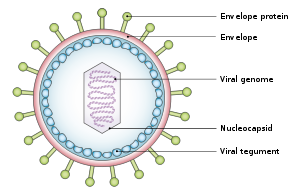This article needs additional citations for verification. (May 2009) |

A viral tegument or tegument, more commonly known as a viral matrix, is a cluster of proteins that lines the space between the envelope and nucleocapsid of all herpesviruses.[1][2] The tegument generally contains proteins that aid in viral DNA replication and evasion of the immune response, typically with inhibition of signalling in the immune system and activation of interferons. The tegument is usually[citation needed] released shortly after infection into the cytoplasm. These proteins are usually[citation needed] formed within the late phase of the viral infectious cycle, after viral genes have been replicated. Much information regarding viral teguments has been gathered from studying herpes simplex virus.[3]
- ^ "Virion tegument". www.uniprot.org. Retrieved 7 May 2019.
- ^ Yu, Xuekui; Shah, Sanket; Lee, Manfred; Dai, Wei; Lo, Pierrette; Britt, William; Zhu, Hua; Liu, Fenyong; Hong Zhou, Z. (2011). "Biochemical and structural characterization of the capsid-bound tegument proteins of human cytomegalovirus". Journal of Structural Biology. 174 (3): 451–460. doi:10.1016/j.jsb.2011.03.006. PMC 3684277. PMID 21459145.
- ^ Mchamstien, Hamm Y.; Mable Mchamstien; Brian J. Yeung (April 2007). "Herpes Simplex Virus Tegument Protein V1 Elucidation and Formation Around the Nucleocapsid". Journal of Virology. 28 (2). American Society for Microbiology: 1262–1274.